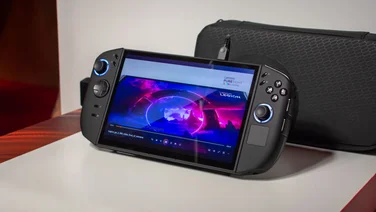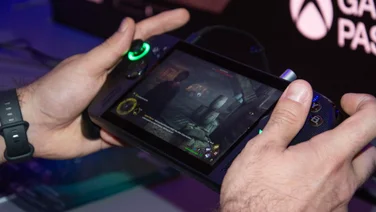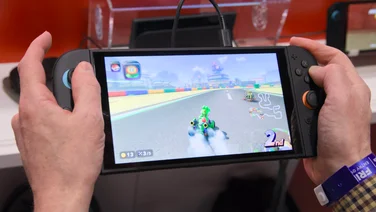To help us provide you with free impartial advice, we may earn a commission if you buy through links on our site. Learn more























- Home console games absolutely anywhere
- An incredible games lineup you won't find anywhere else
- Co-op gaming right out of the box
- A longer battery life would be a nice addition
At launch, we gave the Nintendo Switch a four-star review. At the time, our argument was that, while it was a fantastic console, it lacked a lineup that fully justified the price. On release, it wasn’t clear where Nintendo would go with the Switch nor how much third-party support it would get. We were cautious about singing the praises of a machine that was still unproven – especially considering how badly Nintendo’s previous console, the Wii U, performed.
Now, though, just over a year on since the Nintendo Switch came to market, we’ve come back to readdress our review and give the Switch of 2018 a fair assessment.
Nintendo Switch review: What you need to know
The Nintendo Switch is, effectively, two consoles in one. It’s a gaming hybrid that allows you to have a “traditional” TV-based console experience complete with wireless controller and online play and, when it’s time for you to leave the house or hand the TV remote over to someone else, you can whip the Switch out of its dock and take it with you like a high-powered handheld console.
It’s a melding of two of Nintendo’s greatest strengths: unparalleled handheld gaming hardware, and full-fat, no-compromise first-party games that bring more joy than any other.























READ NEXT: Best Nintendo Switch games
Nintendo Switch review: Price and competition
Because the Nintendo Switch occupies a unique space in the gaming landscape, it doesn’t really have any strict competitors. Sure, in the home console space it’s up against the PS4 and Xbox One and, in the handheld market, there’s competition from smartphones and Nintendo’s own 3DS family of devices. But the Switch isn’t really competing with either.
Switch offers up wholly different experiences from what you’d find on any smartphone, Android-powered tablet with controller or the 3DS. It may run pared down versions of some PS4 and Xbox One games but the attraction is it turns every single home console game on the platform into a portable title, completely changing how you consume and play them.
On the pricing front, it also easily wins out, despite costing more than other consoles. At £280, it’s £80 more than the cheapest you’ll find an Xbox One S for and £30 more than a PS4 Slim, it’s also around £150 more than a New Nintendo 2DS XL. That extra expense can be justified in part that it’s the newer and – in the case of the 2DS XL – more powerful device, and again that it’s two consoles in one.























Nintendo Switch review: Design
The Nintendo Switch, simply said, is unlike anything else on the market. Some may have drawn similarities to the Wikipad – a failed Android tablet-like console with removable screen – but Nintendo’s device is a far slicker proposition.
As you’d expect from Nintendo the Japanese company has thought of everything. Each element of the Switch’s design works seamlessly and, a year on since its initial release, Nintendo is driving home the Switch’s design principles with the release of the ingenious Nintendo Labo.
Built using a similar material to that of Nintendo’s New 3DS and New 2DS XL, the Switch has a sturdy, rugged feel to its design that remains soft and warm to the touch. It’s a device that’s designed to be caressed, thrown into a bag or dropped into a stand. It’s built to be used on the go and designed to withstand the torment younger users might place upon it. and, so far, it’s standing up to all the abuse I – and a number of colleagues who have also bought one – have thrown at it.























READ NEXT: Best Nintendo Switch Cases
The Switch’s main body is the console unit itself. It has a 6.2in screen on its front face and a game cartridge slot, headphone jack, power button and volume rocker situated on the top edge. Along the bottom, you’ll find a USB Type-C connector to deliver fast charge and also work as an HDMI output via the bundled Switch dock that facilitates connection to your TV.
Flanking the Switch’s screen are two “Joy-Cons”, the Switch’s Wiimote-like controllers. These controllers slide in and out of two runners built into the main body of the Switch. You’ll also get a plastic housing, known as the Joy-Con Grip, to slide the controllers into when playing when the Switch is in TV mode for a more traditional console experience.
Each Joy-Con is made to be a self-contained controller as well, so you can pass one side off to a friend and play two-player games on a single Switch unit no matter where you go. To do so, Nintendo has tucked away two buttons in the connecting edge of the Joy Con – labelled SL and SR – to replace the L and ZL (or R and ZR) buttons that previously occupied the shoulder buttons in handheld mode. With the addition of a pair of Joy-Con Straps, these two small buttons suddenly become normal shoulder buttons and a single Joy-Con takes on the appearance of a tiny SNES-like pad.
It’s clear Nintendo has carefully designed the Switch to be a fully portable, multiplayer experience.























Nintendo Switch review: Hardware
On the hardware front, the Switch clearly can’t compete with either the Xbox One or PS4 – let alone the Xbox One X or PS4 Pro. However, it’s still a formidable portable games console thanks to Nvidia’s Tegra X1 chip – the same processor found in Nvidia’s Android-powered Shield TV. Nintendo hasn’t officially released how much RAM there is to back this up, but leaks suggest it’s 4GB, shared between CPU and graphics chip.
The Tegra X1 is capable of pushing out 60fps gameplay to the Switch’s built-in 6.2in 1,280 x 720 resolution LCD touchscreen, and 30fps to a 1080p TV. It will also deliver 60fps on a TV, but most Switch games don’t run at quite that resolution and refresh rate when docked. Going docked does drive more power to the Tegra chip, though, helping boost performance over the power-saving performance in handheld mode.























The most impressive aspect of the Switch hardware, however, is its ability to seamlessly segue between living room and mobile gameplay. Grab the Switch mid-TV session and it instantly carries on playing on the bright LCD screen with absolutely no delay and it works in reverse, too: drop it into the TV dock when you get home and you’ll be able to carry on where you left off, instantly. There’s no pausing, no menu navigation to enable a setting and no extra load time.
READ NEXT: Best handheld consoles
If you’re worried about having to lug the Switch around with you on the go too, don’t be. Not only is it rugged enough to be chucked in a bag – although we definitely recommend grabbing a Switch case to keep it in the best possible condition – it’s relatively lightweight. It may not be as instantly pocketable as a 3DS, but a weight of 398g (with Joy-Cons attached) makes it lighter than an Apple iPad Air 2.
The Joy-Cons themselves are pocket powerhouses in their own right. Both the left and right Joy-Cons come with motion sensing capabilities that are incredibly precise. Surpassing the gyroscopic abilities of both the Wii and Wii U, the Joy-Cons can sense even the slightest tilt or rotation, understanding the speed and smoothness of motion. They both also come with a haptic feedback system Nintendo is calling HD Rumble that, on first use, seems to be little more than a gimmick.























When used properly, however, it’s unlike anything you’ll have found on a games console before. More than a simple vibration it’s capable of creating incredibly lifelike vibrations and is used to great effect in Nintendo Labo as a means to propel an RC car or even recreate notes on a piano.
The only real disappointment with the Nintendo Switch’s hardware is its paltry 32GB of built-in storage and relatively short battery life of four to six hours of undocked play. You can expand your storage via microSD, which is conveniently located under the kickstand, but without a Nintendo Switch Online membership (set to launch later in 2018) you can’t transfer saves off of your Switch console.
Nintendo Switch review: Games and experiences
When the Switch launched it’s here, in the games and experiences section, that I was most critical. Aside from the sublime The Legend of Zelda: Breath of the Wild, there really wasn’t an awful lot to play.























As it turned out, Breath of the Wild and the trickle of interesting indie games were more than enough to keep us busy until the launch of the endlessly addictive Mario Kart 8 Deluxe a month or so later. After that, we had the pleasure of playing ARMS, Splatoon 2, Fire Emblem Warriors, Xenoblade Chronicles 2 and a host of third-party and smaller indie games. The arrival of Super Mario Odyssey was yet another highlight and, by the end of 2017, the Nintendo Switch was able to boast a number of the year’s best releases.
Nintendo has absolutely no intention of letting Switch’s momentum slip. Already we’ve seen the re-release of Bayonetta 2 and around ten new titles land on the Nintendo eShop (the Switch’s digital marketplace) each week, and Nintendo Labo is easily the most creative product to come from Nintendo in years.
And 2018 will continue to see the Switch deliver exciting content with more first-party games arriving on the platform. Most notable among them is the arrival of Super Smash Bros for Switch, Bayonetta 3 and the confirmation of Metroid Prime 4 for either later this year or 2019.
Nintendo Switch review: 2018 verdict
The Nintendo Switch of 2018 is a very different proposition to the Nintendo Switch of March 2017. At the time we thought it was an excellent console that, due to a lack of strong releases, we weren’t sure would was worth investing in. Now, it’s quite clearly an essential purchase for anyone who claims to enjoy gaming.
You may position yourself as a member of the PC Master Race, an Xbox One warrior or a PS4 aficionado, but there’s absolutely no reason why you can’t also own and enjoy a Nintendo Switch alongside any one of these platforms. It offers is a wealth of games you can’t get anywhere else and a level of portability that can’t be matched.
It’s no surprise that the Switch has already surpassed lifetime Wii U sales and shows no sign of stopping. It could even outsell lifetime Xbox One sales within its first two years on sale.
Even if Switch’s online element – Nintendo Switch Online – fails to deliver when it arrives in September, the Switch is already an unmitigated success. Believe the hype around this one, Nintendo really has done it again. The Nintendo Switch is easily the best console of this generation and, quite possibly, one of the best ever made.










